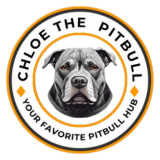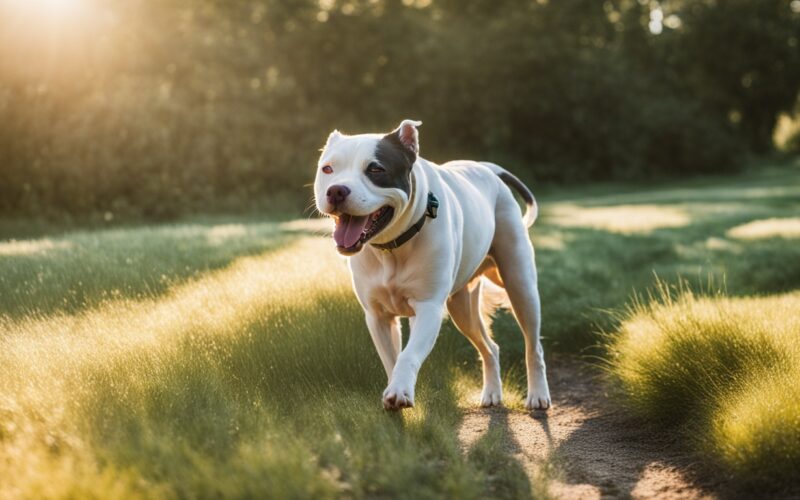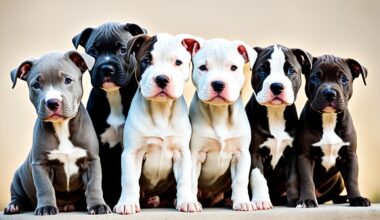Did you have the question “do pitbulls shed?” the answer is yes! and they loose about the same amount all year? This fact often surprises new owners. Despite their strong build and friendly nature, their shedding habits are not well-known.
Pitbull shedding is a way to keep their coat healthy. They have short, smooth fur that sheds all year, a bit more during seasonal changes. Luckily, their short coats make grooming them easier than long-haired breeds.
Knowing how to care for a pitbull’s coat helps with shedding. Regular brushing removes loose fur and keeps their coat shiny.
A balanced diet also helps keep the fur of your pit bull healthy and cuts down on shedding. With the right care, you can manage your pitbull’s shedding and keep your home clean.
The Truth About Pitbull Shedding
Pit bulls do shed, contrary to what many think. They have short hair and they are dense, shedding moderately all year. The amount they shed can change with different breeds and the seasons.
Understanding Pitbull Coat Types
Your pit bull pet’s coats vary from smooth to short and medium lengths. Smooth hair tend to fall off less. A Pitbull does not have an undercoat, which means they loose less dog hair than dogs with double coats.
Factors Influencing Shedding in Pitbulls
Many things can affect how much pitbulls shed:
- Breed type
- Coat type
- Health and genetics
- Diet and nutrition
- Environmental factors
Seasonal Shedding Patterns
Pit bulls shed more in spring and fall as the weather changes. In summer and winter, the hair loss is less. Regular washing, styling and a balanced diet can help reduce the hair and fur from falling off.
“Pitbulls shed minimally throughout the year, with main fallout periods being the winter and spring seasons”
Knowing about pitbull coat types and shedding patterns helps you care for your pet better. With the right grooming and nutrition, you can keep your pitbull’s coat healthy and reduce shedding at home.
Do Pitbulls Shed? Debunking Common Myths
Pitbull shedding myths often say these dogs don’t shed or are hypoallergenic. But, the truth is, pitbulls do shed. They experience less shedding than some breeds but not zero.
Pitbulls have short, smooth fur and they loose a bit all year. Shedding increases during seasonal changes. This helps them adjust to the weather.

Even though pitbulls aren’t hypoallergenic, they can be good for people with allergies. Their short coats have less dander than long-haired breeds. Regular grooming can also cut down on allergens at home.
“Pitbulls passed temperament tests at higher rates than several other popular breeds such as Golden Retrievers and Border Collies.” – National Canine Research Council
Many think pitbulls are low-shedding dogs. But, they tend to shed more than some breeds. Regular brushing and good nutrition are key to managing their shedding and keeping their coat healthy.
- Brush your pitbull weekly to remove loose hair
- Bathe them every 4-6 weeks to keep their hair/fur clean
- Provide a balanced diet rich in omega-3 fatty acids for coat health
Knowing the truth about pitbull shedding clears up common myths. With the right care, you can minimize shedding. This way, you can enjoy the loyalty and love of these dogs.
Pitbull Breeds and Their Shedding Tendencies
Pitbull breeds have short, smooth coats that shed less than double-coated breeds. They also shed during certain times of the year. Let’s look at how different pitbull types shed.
American Pitbull Terrier
The American Pitbull Terrier is a well-known breed. They have a short, dense coat that sheds a moderate amount. They shed twice a year, more during seasonal changes. Regular brushing helps manage shedding in these dogs.
Staffordshire Bull Terrier
Staffordshire Bull Terriers shed like other pitbull breeds. Their short coat needs little grooming but weekly brushing helps during heavy shedding. Their level of shedding increases when the weather changes.
American Staffordshire Terrier
The American Staffordshire Terrier has a short, stiff coat. They shed moderately all year. Regular grooming and a balanced diet with omega fatty acids keep their coat healthy and reduce shedding.
American Bully
American Bullies have a short, smooth coat that sheds little. Though they shed less, routine grooming is still important. Brushing every couple of weeks and bathing during heavy shedding helps manage their coat and prevents skin issues.
“Pitbulls are not heavy shedders, but do go through shedding cycles like all dogs.”
Knowing how different pitbull types shed helps you care for your dog’s coat better. Factors like stress, diet, and health can affect shedding in pitbulls. Regular grooming and proper nutrition are crucial for managing shedding in these dogs.
Managing Pitbull Shedding: Effective Grooming Techniques
Pitbull grooming is crucial for managing fur shedding and maintaining a healthy fur. Regular brushing keeps your pitbull” coat healthy and cuts down on loose hair. Use a soft brush or grooming glove once or twice a week to remove dead hair and spread natural oils.
When shedding a lot, brush more often and think about using a de-shedding tool. This can cut down on hair loss at home. Pitbulls shed less than dogs with longer coats, making them easier to groom.
Bathing your pitbull once a month helps get rid of loose hairs and keeps their coat looking healthy. Use shampoos made for dogs to avoid skin problems. Don’t bathe too much, as it can dry out their skin and make them shed more.
“Regular grooming not only manages shedding but also strengthens the bond between you and your pitbull.”
Different coats need different brushing techniques. For pitbulls with single coats, a soft-bristled brush is best. Those with double coats might do well with a slicker brush to get to the undercoat. Always brush in the hair’s growth direction to prevent skin irritation.
- Brush 1-2 times weekly
- Bathe monthly with dog-specific shampoo
- Use de-shedding tools during peak shedding seasons
- Vacuum regularly to manage loose hair
By adding these grooming tips to your routine, you’ll keep shedding under control and your pitbull looking great.
Nutrition and Its Impact on Pitbull Coat Health
Your pitbull’s diet is key to a shiny, healthy coat. It’s not just about filling their bowl. It’s about giving them the right nutrients for their skin and fur.
Essential Nutrients for a Healthy Coat
A balanced diet for pitbulls should have high-quality proteins, healthy fats, and important vitamins. Look for dog food with 22-32% protein. Adult pitbulls need 1,100-1,700 calories a day, based on how active they are.
Include lean proteins like chicken, beef, or fish. These help with muscle growth and coat health.
Dietary Supplements for Coat Care
Dietary supplements can help your pitbull’s coat. Omega-3 fatty acids are great for skin and coat health. Fish oil supplements can make their skin and coat shine.
Some pitbulls might also need joint supplements like glucosamine and chondroitin. These support their health and how well they move.
The Role of Hydration in Coat Maintenance
Don’t forget about water! It’s crucial for coat health. Make sure your pitbull always has fresh, clean water to drink.
This keeps their skin elastic and helps their coat stay healthy and shiny. Remember, dry dog food has less than 12% water. So, pitbulls eating mainly kibble might need more water encouragement.
“A well-hydrated pitbull is a healthy pitbull. Water is essential for every bodily function, including maintaining a beautiful coat.”
By focusing on proper nutrition, using supplements, and keeping them hydrated, you can boost your pitbull’s coat health. A balanced diet will make your dog look and feel great!
Health Concerns Related to Excessive Shedding in Pitbulls
Excessive shedding in dogs can be a sign of health problems. Pitbulls shed moderately throughout the year due to their short coats. If your pitbull sheds more than usual, it’s key to know the possible causes and when to get vet help.
Common Skin Conditions
Skin issues in pitbulls can cause a lot of shedding and discomfort. These issues include:
- Allergies (environmental or food-related)
- Parasites (fleas, ticks, or mites)
- Skin infections
- Hormonal imbalances
Regular grooming and a balanced diet can prevent many of these problems. Brush your pitbull’s coat once or twice a week to spread natural oils and remove loose hair.

Allergies and Their Effect on Shedding
Allergies often lead to excessive shedding in dogs. Pitbulls may react to certain foods, environmental factors, or grooming products. Symptoms include more scratching, skin irritation, and hair loss. If you think your pitbull has allergies, talk to your vet to find the cause and get a treatment plan.
When to Consult a Veterinarian
See a vet if you notice:
- Sudden changes in shedding patterns
- Bald patches or thinning coat
- Skin redness, irritation, or scabs
- Excessive scratching or biting at the skin
- Changes in appetite or behavior
Acting early can stop minor issues from becoming big health problems. A healthy diet, regular exercise, and proper grooming are crucial for your pitbull’s coat and overall health.
Conclusion
Pitbulls shed, but you can manage it with the right care. They have short, smooth coats that tend to fall off a lot, especially in spring and fall. Regular brushing, two to three times a week, helps remove loose fur and spreads natural oils.
For a healthy coat, feed them a diet full of omega fatty acids and vitamin C. This supports coat health and cuts down on increased shedding. Don’t over-bathe them, as it can irritate their skin and cause more shedding. Use gentle dog shampoos when you bathe them.
Shedding can be affected by age, stress, and health. Watch for any sudden changes in shedding, as it could mean a health issue. With good grooming and health care, you can keep your home clean and your pitbull happy and healthy.



28 comments
Your article helped me a lot, is there any more related content? Thanks!
Your article helped me a lot, is there any more related content? Thanks!
Your point of view caught my eye and was very interesting. Thanks. I have a question for you.
Thanks for sharing. I read many of your blog posts, cool, your blog is very good.
Your article helped me a lot, is there any more related content? Thanks!
Your article helped me a lot, is there any more related content? Thanks!
Thank you for your sharing. I am worried that I lack creative ideas. It is your article that makes me full of hope. Thank you. But, I have a question, can you help me?
Thank you for your sharing. I am worried that I lack creative ideas. It is your article that makes me full of hope. Thank you. But, I have a question, can you help me?
Your point of view caught my eye and was very interesting. Thanks. I have a question for you. https://accounts.binance.com/ar-BH/register?ref=V2H9AFPY
Your point of view caught my eye and was very interesting. Thanks. I have a question for you.
Thank you for your sharing. I am worried that I lack creative ideas. It is your article that makes me full of hope. Thank you. But, I have a question, can you help me? https://accounts.binance.com/sk/register?ref=OMM3XK51
Can you be more specific about the content of your enticle? After reading it, I still have some doubts. Hope you can help me.
Can you be more specific about the content of your article? After reading it, I still have some doubts. Hope you can help me.
Thank you for your sharing. I am worried that I lack creative ideas. It is your article that makes me full of hope. Thank you. But, I have a question, can you help me?
Thanks for sharing. I read many of your blog posts, cool, your blog is very good.
I don’t think the title of your article matches the content lol. Just kidding, mainly because I had some doubts after reading the article. https://accounts.binance.info/en-IN/register?ref=UM6SMJM3
Can you be more specific about the content of your article? After reading it, I still have some doubts. Hope you can help me.
Thanks for sharing. I read many of your blog posts, cool, your blog is very good. https://www.binance.info/ru-UA/register-person?ref=OMM3XK51
Your point of view caught my eye and was very interesting. Thanks. I have a question for you.
Thank you for your sharing. I am worried that I lack creative ideas. It is your article that makes me full of hope. Thank you. But, I have a question, can you help me? https://www.gate.io/ru/signup?ref_type=103&ref=XwNAUwgM
Your point of view caught my eye and was very interesting. Thanks. I have a question for you.
Thank you for your sharing. I am worried that I lack creative ideas. It is your article that makes me full of hope. Thank you. But, I have a question, can you help me?
Your article helped me a lot, is there any more related content? Thanks!
Your point of view caught my eye and was very interesting. Thanks. I have a question for you.
I don’t think the title of your article matches the content lol. Just kidding, mainly because I had some doubts after reading the article.
Your article helped me a lot, is there any more related content? Thanks!
Your article helped me a lot, is there any more related content? Thanks!
Your article helped me a lot, is there any more related content? Thanks!